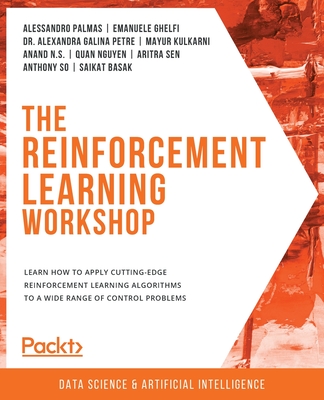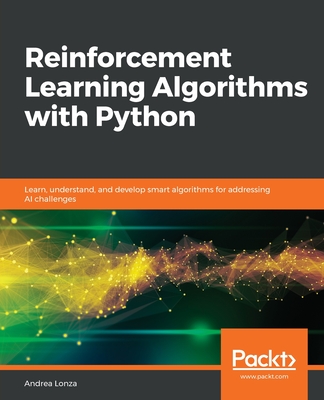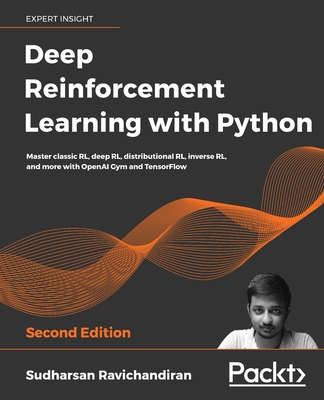Hands-On Q-Learning with Python
暫譯: 使用 Python 實作 Q-Learning
Nazia Habib
- 出版商: Packt Publishing
- 出版日期: 2019-04-17
- 售價: $1,500
- 貴賓價: 9.5 折 $1,425
- 語言: 英文
- 頁數: 212
- 裝訂: Paperback
- ISBN: 1789345804
- ISBN-13: 9781789345803
-
相關分類:
Reinforcement
海外代購書籍(需單獨結帳)
買這商品的人也買了...
-
 $534機器交易:利用算法贏得市場先機
$534機器交易:利用算法贏得市場先機
相關主題
商品描述
Key Features
- Understand how Q-learning algorithms are used to train neural networks to solve Markov decision processes (MDPs)
- Study practical deep reinforcement learning using Q-networks
- Explore state-based unsupervised learning for machine learning models
Q-learning is a machine learning algorithm used to solve optimization problems in artificial intelligence (AI). It is one of the most popular fields of study among AI researchers. This book starts off by introducing you to reinforcement learning and Q-learning, in addition to helping you get familiar with OpenAI Gym as well as libraries such as Keras and TensorFlow.
A few chapters into the book, you will gain insights into model-free Q-learning and use deep Q-networks and double deep Q-networks to solve complex problems. This book will guide you in exploring use cases such as self-driving vehicles and OpenAI Gym's CartPole problem. You will also learn how to tune and optimize Q-networks and their hyperparameters. As you progress, you will understand the reinforcement learning approach to solving real-world problems. You will also explore how to use Q-learning and related algorithms in real-world applications such as scientific research. Toward the end, you'll gain a sense of what's in store for reinforcement learning.
By the end of this book, you will be equipped with the skills you need to solve reinforcement learning problems using Q-learning algorithms with OpenAI Gym, Keras, and TensorFlow.
What you will learn
- Explore the fundamentals of reinforcement learning and the state-action-reward process
- Understand Markov decision processes
- Get well-versed in libraries such as Keras and TensorFlow
- Create and deploy model-free learning and deep Q-learning agents with TensorFlow, Keras, and OpenAI Gym
- Choose and optimize a Q-network's learning parameters and fine-tune its performance
- Discover real-world applications and use cases of Q-learning
商品描述(中文翻譯)
主要特點
- 了解 Q-learning 演算法如何用於訓練神經網絡以解決馬可夫決策過程 (MDPs)
- 研究使用 Q-networks 的實用深度強化學習
- 探索基於狀態的無監督學習以應用於機器學習模型
Q-learning 是一種用於解決人工智慧 (AI) 中優化問題的機器學習演算法。它是 AI 研究人員中最受歡迎的研究領域之一。本書首先介紹強化學習和 Q-learning,並幫助您熟悉 OpenAI Gym 以及 Keras 和 TensorFlow 等庫。
在書中的幾個章節後,您將深入了解無模型的 Q-learning,並使用深度 Q-networks 和雙深度 Q-networks 來解決複雜問題。本書將指導您探索自駕車和 OpenAI Gym 的 CartPole 問題等用例。您還將學習如何調整和優化 Q-networks 及其超參數。隨著進展,您將理解強化學習在解決現實世界問題中的方法。您還將探索如何在科學研究等現實應用中使用 Q-learning 和相關演算法。到最後,您將對強化學習的未來有一個概念。
在本書結束時,您將具備使用 Q-learning 演算法解決強化學習問題所需的技能,並能夠運用 OpenAI Gym、Keras 和 TensorFlow。
您將學到的內容
- 探索強化學習的基本原理及狀態-行動-獎勵過程
- 了解馬可夫決策過程
- 熟悉 Keras 和 TensorFlow 等庫
- 使用 TensorFlow、Keras 和 OpenAI Gym 創建和部署無模型學習和深度 Q-learning 代理
- 選擇和優化 Q-network 的學習參數並微調其性能
- 發現 Q-learning 的現實應用和用例
作者簡介
Nazia Habib is a data scientist who has worked in a variety of industries to generate predictive analytics solutions for diverse groups of stakeholders. She is an expert in building solutions to optimization problems under conditions of uncertainty. Her projects range from predicting user behavior and engagement with social media apps to designing adaptive testing software. Her ongoing specialization is in designing custom reinforcement learning algorithms for modeling control problems with limited inputs that converge to optimal solutions.
作者簡介(中文翻譯)
Nazia Habib 是一位數據科學家,曾在多個行業中工作,為不同的利益相關者生成預測分析解決方案。她在不確定性條件下解決優化問題方面具有專業知識。她的項目範圍從預測用戶行為和社交媒體應用的參與度到設計自適應測試軟體。她目前專注於設計自訂的強化學習演算法,以建模具有有限輸入的控制問題,並收斂到最佳解決方案。
目錄大綱
- Brushing Up on Reinforcement Learning Concepts
- Getting Started with the Q-Learning Algorithm
- Setting Up Your First Environment with OpenAI Gym
- Teaching a Smartcab to Drive Using Q-Learning
- Building Q-Networks with TensorFlow
- Digging Deeper into Deep Q-Networks with Keras and TensorFlow
- Decoupling Exploration and Exploitation in Multi-Armed Bandits
- Further Q-Learning Research and Future Projects
- Assessments
目錄大綱(中文翻譯)
- Brushing Up on Reinforcement Learning Concepts
- Getting Started with the Q-Learning Algorithm
- Setting Up Your First Environment with OpenAI Gym
- Teaching a Smartcab to Drive Using Q-Learning
- Building Q-Networks with TensorFlow
- Digging Deeper into Deep Q-Networks with Keras and TensorFlow
- Decoupling Exploration and Exploitation in Multi-Armed Bandits
- Further Q-Learning Research and Future Projects
- Assessments





























